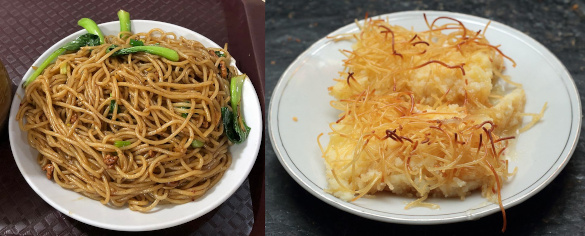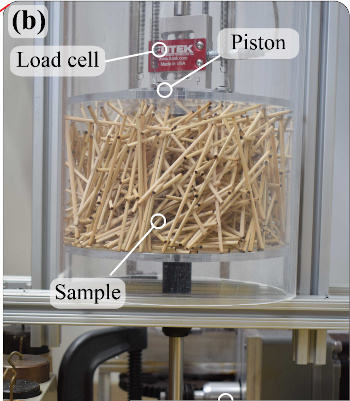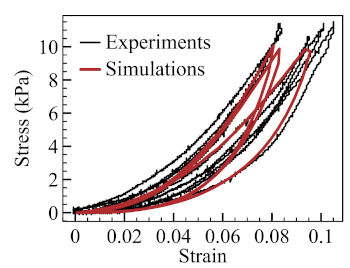Bird Nest Mechanics
November 7, 2022
I was
born and
raised in a mid-sized
city in
Upstate New York populated almost evenly by first and subsequent
generation Italians and
Poles. As an illustration of the proverb,
birds of a feather flock together, the Italians generally lived on the
east side of the city, while the Polish lived on the
west. My
brothers and I had a Polish
mother and an Italian
father; so, we were
fed a variety of Italian and Polish
foods. I never had any
Chinese food until I was away at
college.
Scientists are constantly creating
theories in order to understand their
world; so, when I first heard about the Chinese
delicacy,
bird's nest soup, I was certain that this was a
culinary simulation of a
bird nest created using
rice noodles dropped into a
bowl of
soup. How surprised I was to learn that the soup is made from actual bird's nests formed by
swiftlets from their
solidified saliva. While this seems
unappetizing to
Westerners, there's a close
analogy here to
honey, a
product of
honey bee regurgitation.

Culinary bird nests - Rice noodles (left) and knafeh (right). Rice noodles can be arranged to appear as a bird nest, but knafeh, a Middle Eastern dessert made using the spun pastry, kataifi, is a closer simulation. Greek Baklava is sometimes made to have the same appearance as knafeh. (Left image, Stir-fried rice noodles in Nanchang by N509FZ. Right image, Knafeh made by Syrian immigrants in Argentina by Carlos Disogra. Both images from Wikimedia Commons. Click for larger image.)
Many
stereotypes have be
reinforced through
cartoons, and this is true for our
perception of how a bird nest should appear. While
birds have nests in everything from
tree hollows to
sand and
soil pits, the
popular ideal of a bird nest is the
cup nest. These are the nests of the
Passeriformes, or
perching birds, which encompass the majority of all bird
species, and this nest type is the
layout of
Big Bird's nest. Cup nests are made from
flexible materials such as
grass and
twigs that offer
safety and
thermal insulation for
eggs and
fledglings.
A
plethora of
experiments come into a scientist's
mind upon
reading the preceding
paragraph. How thermally insulating are bird nests? What is the
mechanical strength of a bird nest? How do these vary between species and
geographical location? Will
global warming be a factor in the
quality and abundance of nest materials, and will the diminished quality of nests be a factor in bird species
extinction?
A team of scientists and
engineers have
published a
paper describing their
research on the
mechanical plasticity and
hysteresis of nest-like structures.[1-3] The team members are from the
University of Illinois at Urbana-Champaign (Urbana, Illinois) and the
University of Akron (Akron, Ohio). The nest-like structures were
random packing of
unbonded, semi-flexible
fibers.[1-2] Their experiments used
bamboo sticks to simulate twig-based bird nests, and they developed
computer simulations of nest
mechanics.[1-2]
Granular materials exhibit unique behaviors, and it's suggested that nest-like structures are a type of granular material intermediate between random
ellipsoidal grains, such as
rice, and
tangled fibers.[3] The nest-like structures are less
rigid than rice, but more rigid than tangled fibers.[3] This study found that nest-like structures are
elastic with a
non-linear stress-strain curve.[1-3] The stress-strain curve also exhibits hysteresis, a feature likewise found in the
compaction of low
aspect ratio ellipsoidal particles (e.g., rice) and indicative of
energy loss from
frictional rubbing between the nest elements.[3] The hysteresis was also repeatable and
velocity independent.[1-2]

The nest mechanics experimental setup.
The rods were 76 millimeter (3 inches) long with a diameter of 2.45 millimeter (0.1 inch) and made from bamboo. The aspect ratio of the rods was 31; that is, the rods were thirty-one times longer than wide.
The cylindrical container was 140 millimeter in diameter.
(Fig. 1(b) of Ref. 2)[2]
![]()
The experiments were on 76 mm long bamboo rods with an
aspect ratio of 31; that is, the rods were thirty-one times longer than
wide.[1-3] In their experiments, the research team used
computer-assisted X-ray tomography to create
three-dimensional maps of the
points of
contact between the rods as they were
cycled through compaction.[3] It was found that the
distribution of contact points between the nest elements was a determining
parameter in the mechanical properties of the nest.[3]
Compression increased the contact points, and the contact points restrict further bending. As a consequence, increased compaction leads to a stiffer nest, and this causes the non-linear stress-strain curve.[1-3] Overcoming
static friction during release from compaction causes an
asymmetry in the hysteresis loop.[3]
The experiment differs from an actual nest in one important way. Nests are not confined by a container. As seen in the figures, the container diameter is not much larger than the rod length. Paper
author,
Hunter King of the University of Akron says that the team has planned subsequent experiments in which they hope to
extrapolate the mechanical behavior to that of an
infinite nest, but there's still the question of whether a containerless nest of untangled rods would be self-supporting.[3] Even if containers are required, nest-like filling of mechanical structures might have useful applications.[3]

Experimental stress-strain curves (gray) and simulated response (red) for quasistatic stress-strain cycles.
Considerable hysteresis is evident (The basis for a novel mechanical heater?).
(Click for larger image.)
![]()
References:
- Yashraj Bhosale, Nicholas Weiner, Alex Butler, Seung Hyun Kim, Mattia Gazzola, and Hunter King, "Micromechanical Origin of Plasticity and Hysteresis in Nestlike Packings," Phys. Rev. Lett., vol. 128, no. 19 (May 13, 2022), Article no. 198003, DOI:https://doi.org/10.1103/PhysRevLett.128.198003.
- arXiv version of ref. 1, December 1, 2021.
- Philip Ball, "Explaining the Mechanics of a Bird's Nest," Physics, vol. 15, no. 72 (May 13, 2022).
Linked Keywords: Birth; born; parenting; raised; city; Upstate New York; populated; generation; Italians; Poles; birds of a feather flock together; east; west; brother; mother; father; eating; feed; food; Chinese cuisine; Chinese food; college; scientist; theory; theories; universe; world; delicacy; bird's nest soup; culinary arts; culinary; simulation; bird nest; rice noodles; bowl; soup; swiftlet; solid; solidified; saliva; appetite; unappetizing; Western world; Westerners; analogy; honey; product; honey bee; regurgitation (digestion); knafeh; Middle East; Middle Eastern; dessert; spinning (textiles); spun; pastry; kataifi; simulation; Greece; Greek; Baklava; Nanchang; N509FZ; Wikimedia Commons; stereotype; reinforcement; reinforce; animated cartoon; perception; bird; tree hollow; sand; soil; pit; mainstream; popular; ideal (ethics); cup nest; Passerine; Passeriformes; species; design; layout; Big Bird; deflection (engineering); flexible; material; grass; twig; safety; thermal insulation; egg; fledge; fledgling; plethora; experiment; mind; reading (process); paragraph; strength of materials; mechanical strength; geography; geographical location; global warming; quality (philosophy); extinction; engineer; scientific literature; publish; paper; research; plasticity (physics); mechanical plasticity; hysteresis; University of Illinois at Urbana-Champaign (Urbana, Illinois); University of Akron (Akron, Ohio); randomness; random; packing; adhesion; unbonded; fiber; bamboo; branch; stick; computer simulation; mechanics; granular material; ellipsoid; ellipsoidal; grain; rice; tangle; stiffness; rigid; elasticity (physics); elastic; linearity; non-linear; stress-strain curve; compaction; aspect ratio; energy; friction; frictional; rubbing; velocity; independent variable; experimental setup; rod (geometry); millimeter; inch; length; long; diameter; wide; cylinder (geometry); cylindrical; container; X-ray computed tomography; computer-assisted X-ray tomography; three-dimensional space; map; point (geometry); contact; periodic function; cycle; probability distribution; parameter; compression (physics); static friction; asymmetr; academic authorship; author; Hunter King; extrapolation; extrapolate; infinity; infinite; quasistatic loading.